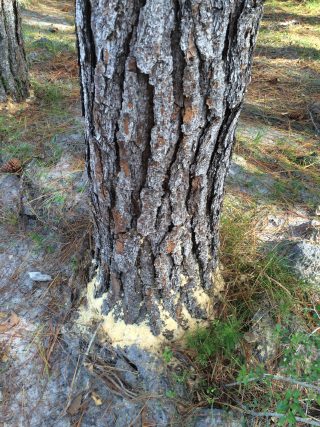Questions come into the Extension Office from time to time about why sawdust is accumulating around remaining trees on recently cleared or developed tracks of forested land. The sawdust is more than likely a sign that ambrosia beetles are on the offensive.
The ambrosia beetle, Platypus spp., is a member of a large family of species known as Platypodidae. Most species are found in the tropics, with very few species found in Florida. This beetle is a type of boring insect, which are attracted to recently killed trees with high moisture content. Adult males initiate the boring into the tree and develop galleries, which are tunnel like mazes just under the bark layer. Males are joined by a single female during this event. Pheromones are released at this point, signaling more ambrosia beetles to descend into the area, which in turn causes simultaneous attacks on trees. Mated pairs tunnel throughout the sapwood, but rarely into the heartwood. The tunnels are where larvae are produced. Adults eventually emerge from the original entry hole.
Due to the ambrosia beetle’s natural attraction to freshly cut dead wood, the beetle can be a pest to the lumber industry, causing economic damage. It is also an issue when thinning trees for housing developments. Equipment scrapes on tree trunks can lead to a slow demise and in turn attract ambrosia beetles, which accelerates the demise. This can lead to quick, unwanted tree death in real estate landscapes. The beetle is a common culprit of tree death, simply because of the number of beetles typically found in dead or dying trees. However, it is very rare for the ambrosia beetle to attack healthy trees. Even if ambrosia beetle damage on a healthy tree has been documented, it is quite likely that the tree was already under duress. Excess water is often the underlying natural issue.
Typically, there is no active management protocol, as the beetle attacks dying or dead trees. However, land clearing is a typical cause of why ambrosia beetles thrive in some areas. Trees can be accidentally damaged by equipment during this process. Equipment scrapes and trenching activities that damage the root systems are just some examples.
For more information please contact your local county extension office.
More information on this topic can be found in the following the UF/IFAS publications:
A Guide to Florida’s Common Bark and Ambrosia Beetles
Ambrosia Beetles Platypus spp.
An ambrosia beetle Xyleborus affinis Eichhoff, 1868
- Managing Pine Stands for Straw Production - January 10, 2025
- Disaster Preparedness for the Ranch - June 21, 2024
- Winter Storm Damage to Your Honeybee Operation? Federal Disaster Assistance Program Could Help - January 12, 2024

